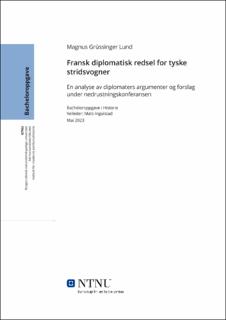| dc.contributor.advisor | Ingulstad, Mats | |
| dc.contributor.author | Lund, Magnus Grüssinger | |
| dc.date.accessioned | 2023-06-24T17:19:33Z | |
| dc.date.available | 2023-06-24T17:19:33Z | |
| dc.date.issued | 2023 | |
| dc.identifier | no.ntnu:inspera:144860699:64460959 | |
| dc.identifier.uri | https://hdl.handle.net/11250/3073052 | |
| dc.description.abstract | Denne oppgaven vil ta for seg nedrustningskonferansen i Genève 1932-34. Denne konferansens mål var å kunne nedruste alle deltagende land på en lik måte. For at konferansen kunne starte ville man se at Tyskland var en deltagende nasjon, og ville tre ut av begrensningene satt etter første verdenskrig. Fra denne deltagelsen av Tyskland ville de vise seg en reaksjon fra de franske diplomatene allerede før konferansens start. I denne oppgaven vil det da bli sett på de franske diplomatenes reaksjon på en mulig tysk opprustning, med da det sentrale våpenet stridsvognen. Stridsvognen ville vise seg fram som ett nytt våpen fenomen under første verdenskrig, og under konferansen var den sentral i diskusjoner fra Land kommisjonen. Denne reaksjonen til de franske diplomatene vil da også beskrives ved relasjonen mellom de to landene, som årene før viser seg å være vanskelig, men tar også for seg hvordan de franske diplomater brukte denne relasjonen til Tyskland for å styrke sine argumenter innad i konferansen. bakgrunnen og tidligere forskningen i oppgaven vil legge fram da konferansens gang, stridsvognens historie og vise stridsvogns teoretikeres perspektiv på stridsvognen i mellomkrigstiden, i en offensiv og defensiv stilling. Funnene til denne oppgaven vil da vise fram en sammenheng mellom bakgrunnen og diskusjonen, og viser fram hvordan franske diplomater arbeidet for å ikke gi Tyskland stridsvogner. | |
| dc.description.abstract | This thesis will take on the disarmament conference in Geneva 1932-34. The aim of this conference was to be able to disarm all participating countries in an equal way. In order for the conference to start, it would be seen that Germany was a participating nation, and would step out of the restrictions set after the First World War. From this participation of Germany, it would show a reaction from the French diplomats even before the start of the conference. In this thesis, the reaction of the French diplomats to a possible German rearmament will be looked at, with the central weapon being the tanks. The tank would prove to be a new weapon phenomenon during the First World War, and during the conference it was central to discussions from the Land Commission. This reaction of the French diplomats will then also be described in terms of the relationship between the two countries, which in previous years proved to be difficult, but also considers how the French diplomats used this relationship with Germany to strengthen their arguments within the conference. the background and previous research in the thesis will then present the course of the conference, the history of the tank and show the perspective of tank theorists on the tank in the interwar period, in an offensive and defensive position. The findings of this thesis will then show a connection between the background and the discussion, and show how French diplomats worked to not give Germany tanks. | |
| dc.language | nob | |
| dc.publisher | NTNU | |
| dc.title | Fransk diplomatisk redsel for tyske stridsvogner | |
| dc.type | Bachelor thesis | |
